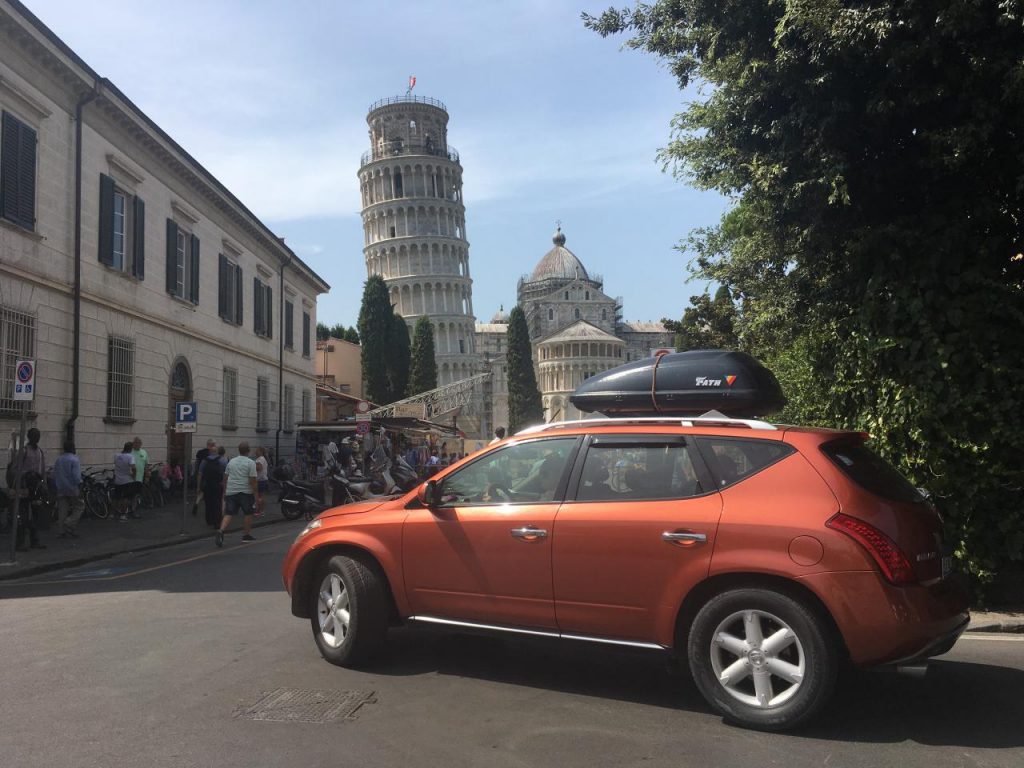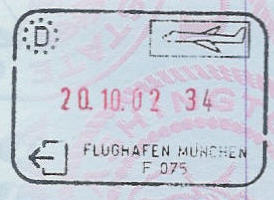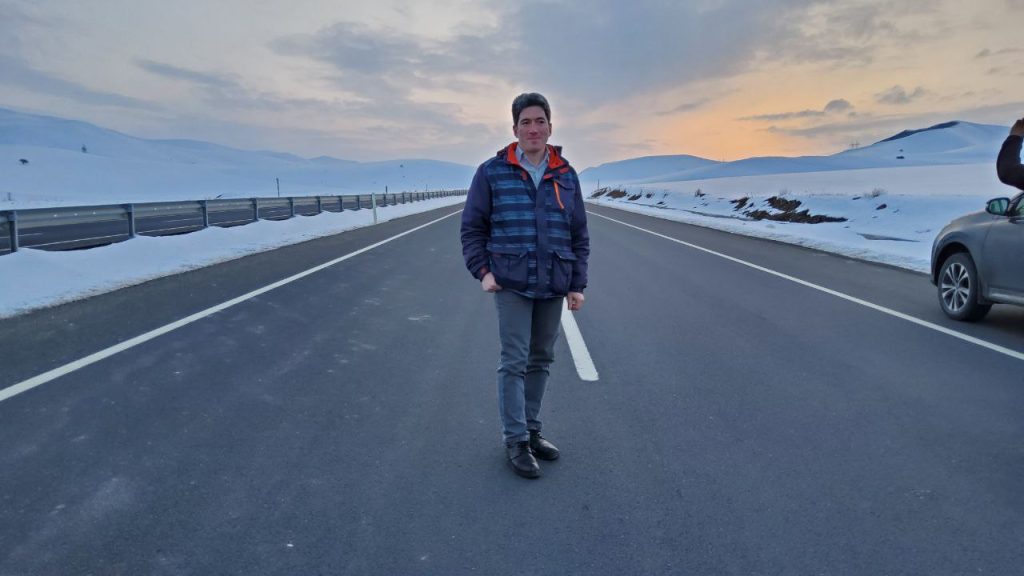Explanation:
This trip was planned with the previous plan for this summer (2016), so that we can take advantage of the children’s summer vacation and travel to Europe with a private car to take advantage of all the excitement.
In this travelogue we read:
- Went path
- Return path
- How to get a visa
- Travel essentials
- The start of the journey
- Arrival in Greece
- Arrival in Italy
- Mont Blanc and its famous tunnel
- Arrival in France
- Arrival in switzerland
Went path:
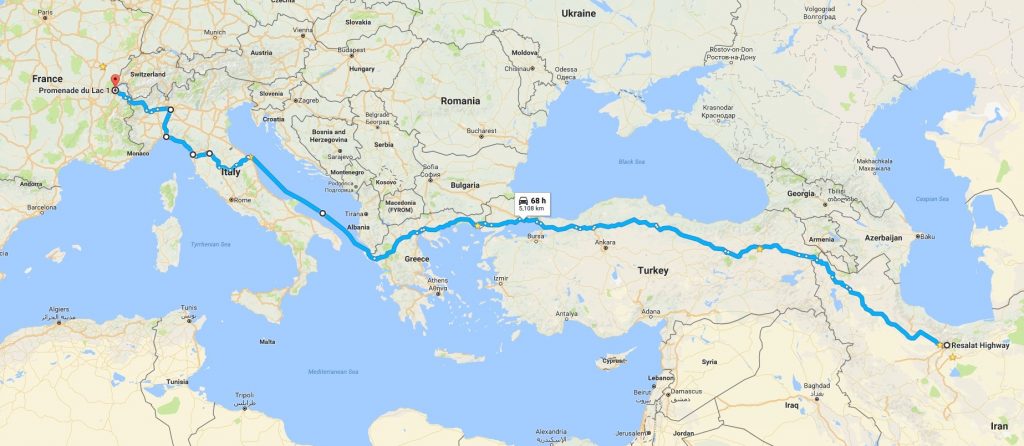
By order:
- Tehran
- Bazargan Border
- Erzurum
- Ankara
- Istanbul
- Ipsala Border
- Greece
- Igoumenitsa Port
- Ancona Port
- Italy
- Florance
- Pizza
- Milan
- France
- Switzerland
Return Path:
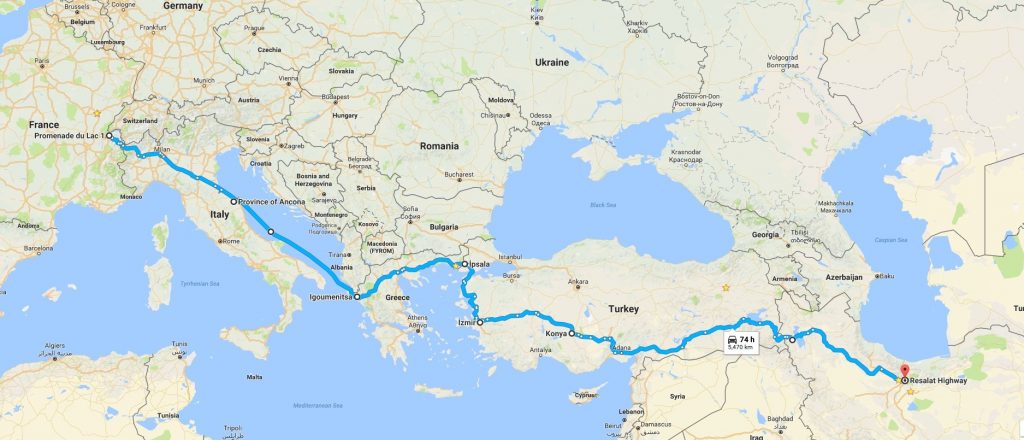
By order:
- Switzerland
- France
- Italy
- Milan
- Anconna Port
- Igoumentisa Port
- Greece
- Ipsala border
- Torkey
- Izmir
- Alacati
- Konya
- Diyarbakır
- Sero border
- Tehran
Part 1 - Getting Visa
The visa was obtained through the French Embassy. Because I also had previous visas from here as usual with work documents and financial entitlements, as well as this series with car documents and travel plans and travel schedules, I told the case manager that this time we intended to travel to France and Europe with a personal car and across the Greek border and they said there was no problem. (There is no problem with entering Malta from a third country to the Shengen border)
The visa cost €60 for me, my wife and oldest son (14 years old), €30 for my 10-year-old son and €30 free for my youngest son (3 years old).
Par2 - Requirements
Required supplies for long-term travel by car
- Coolbox
- dish & laundry, Washing detergent, …
- Electric tea maker or hot water biler (City electric or Car electricity)
- 12V DC to 220V Inverter at least 1000 watts for refrigeration, charging accessories, lighting plugs, Rice maker, Kettel and…
- Bathroom accessories include soap, shampoo, rasor and ….
- Drinks, glasses, one-time dishes and glasses.
- Water refinery pills or filter for make drinking water .
- Spoon, fork, Knife, Can opener and ….
- Air compressor & Air gauge.
- Car puncture repair kit.
- Picnic stove.
- walkie talkie.
- Pot, Frying pan, Aluminum kettle.
- Roof box to put sleeping things and luggages for preferably the trunk is empty
- A cover or cloth to cover the rear loads of the car.
- Lighter, a match, charcoal, Fire starter.
- GPS and compass and download maps of required and neighboring countries during the trip.
- Small grill, barbecue skewers, net, barbecue fan.
- The wheel chain (depending on the season).
- Tea/sugar/sweets and salt.
- Address and telephone of authorized car repair stations on the roads.
- Oil / Rice / Conserves / Dried Bread.
- Front Cover of the car to prevent collisions of stones and insects and also cross the river.
- Dry fruits / Mineral water / Chocolate / Nuts.
- Motor oil/oil filter/air filter/brake pad and other necessary equipment and accessories such as Engine belt and fuse.
- Toothpaste and toothbrush.
- Personal items such as towels, shaver, scissor.
- Sewing supplies, thick thread, rubber band, pin, Button, needle.
- Small plastic garbage for car interior, large and zip bag.
- a gallon of water.
- Safety Whistle.
- Anti-mosquito ointment and spray.
- blanket, mat, nderlay, carpet.
- Laptop, Tablet, iPad.
- Sheets for sleeping, pillowcases.
- Power Strip (long) For using in campsite and LED lamp.
- Slippers and shoes.
- Sunshade for the inside of the car.
- First aid box and necessary medicines.
- Car refrigerator or small 220V refrigerator connected to the inverter.
- Flashlight and emergency light + battery (rechargeable and normal) battery charger.
- Travel tent, sleeping bag and backpack.
- Wrench and tool bag, some bolts and nuts in different sizes.
- Folding chair, mosquito net and rope cradle.
- Personal and car identification documents, insurance book, international personal and car insurance, several personal photos, several sets of copies of documents especially passport / car book and international driver’s license.
- Jackets, warm and cold clothes, woolen hats, sun hats, sunglasses and umbrellas.
- Making copies of all identification documents and keeping them in a safe place, not next to the original documents, as well as scanning all documents and sending them to your email.
- Photography and video camera and tripod with additional film and memory.
- Country labels on cars (European road laws).
- Danger triangle / yellow vest (European road law).
- Music Accessories, MP3 Player, Memory Card and Related Cables.
- Electric and car charging of mobile phones.
- Carrying a list of essential telephone numbers for each country you pass through: police, tourist police, road assistance and…
- Some electrical wires and belts
- Bicycle tube and tape
- Address and phone numbers of Iranian embassies in transit countries
- tow rope cable
- Shovel
- Waist wallet for securing under clothes
- Wide adhesive tape and electrical tape
- Hammer, large knife, small saw
- One remote control, spare car key
- Large lightweight umbrella with string or thin rope for fastening
- Folding table and chair (suitcase type) for eating
- Hairdryer and iron
- Rope and clothesline
- 2-in-1 electric heater, both warm and cool (fan)
Part 3 - Beginning of the trip
Due to heavy traffic and the torturous Tehran-Karaj highway, we started our journey towards a garden we have in Karaj at 1:30 AM on 30/5/96.
After buying supplies, including pre-made meals from the Shahravand supermarket, we reached the garden and took a rest there.
The next morning at 9:30, we started our journey towards the Bazargan border.
This route, which is 901 kilometers long, passes through the following locations:
Tehran – Karaj – Hashtgerd – Abiyek – Shahrekord-e Mohammadiyeh – Takestan – Abhar – Khorramdarreh – Zanjan – NikPey – Bostanabad – Tabriz – Sufian – Marand – Iğdır – Qareh Ziyaeddin – Merganlar – Bazargan.
In my opinion, a trip is not just about reaching the destination; it starts from the moment you begin the journey, and you should also enjoy it along the way. Therefore, avoid unnecessary haste and rushed driving, and create a sense of tranquility for yourself and your companions.
Also, for information about domestic trips, you can use the route planning system of the Road Maintenance and Transportation Organization.
Furthermore, to get accurate information about the borders of Turkey and their names, you can refer to this link from both countries.
We arrived in Zanjan at 13:30 and after having a meal, resting for a while, and performing prayers, we departed for Tabriz at 14:30.
Finally, we reached the Bazargan border at 23:00. At the Bazargan border, you need to present the customs form, Turkish insurance policy, individual exit fees of 25,000 Tomans, and the customs declaration for the car. Accordingly, we entered Turkey at 24:00.
By the way, the Turkish name for the Bazargan border is Gürbulak.
After entering Turkey, as we had previously visited most of the cities on the route, we moved directly towards Istanbul without stopping in those cities and using the beltways.
Then, we rested in the city of Erzincan and departed for Istanbul at 5 AM. On the way to Istanbul, we encountered heavy rain and fog, which significantly slowed down our progress. Eventually, we arrived in Istanbul at 1 AM on 1/6/96 and spent the night in a hotel.
Note: During car trips, you can stay in hotels on the outskirts or a few hundred kilometers away from major cities as they are much cheaper.
The next morning, we headed towards the Greek border from Istanbul.
On the way, European vehicles were moving at incredibly high speeds, exceeding the legal limits. I thought to myself, maybe the speed cameras don’t work for European cars. We reached the long queue of vehicles at the Pazarkule Customs at 15:10.
We just realized the reason for the high speeds of the cars: “To reach the border faster and get ahead in
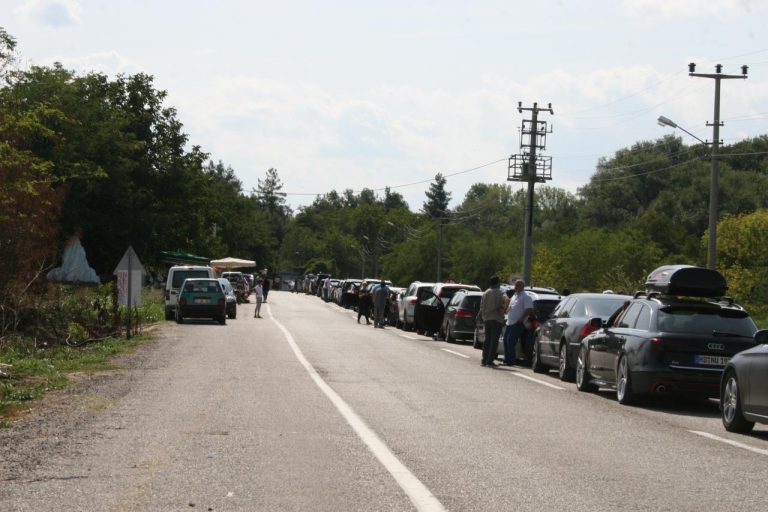

Important Notice: Please obtain international car insurance (Green Card) from Iran…
Friends who have traveled to Europe with their private cars have written in their memoirs that they obtained European Green Card insurance from Iran. After an accident occurred in Europe, their Iranian insurance was worthless there, and even though they were not at fault, they couldn’t claim compensation from the responsible party and returned to Iran empty-handed.
Considering this experience, I thought it would be better to get insurance from Turkey or Europe itself. Therefore, I entered the border without insurance. However, Pazarkule is not the official border of Greece; the main border between Turkey and Greece is Ipsala.
To avoid any trouble, after a long delay, we exited Turkey at 17:05 and stood in line to enter Greece.
At 20:40, it was our turn to reach the border of Maras, but due to not having the Green Card (European international insurance), they did not allow us to enter Greece, and we were forced to return to Turkey.
Later, we found out that Turkey cannot issue European insurance, so we had no choice but to head towards the Ipsala border.
The distance from Pazarkule border to Ipsala was about 100 kilometers. After reaching this border, we stood in line for approximately 6 hours and managed to obtain one-month car insurance from the Greek police for a fee of 180 euros.
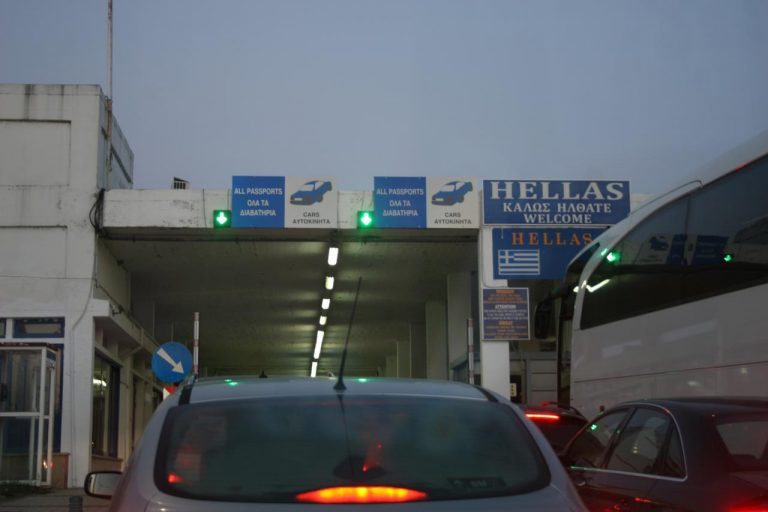

Part 4 - Entering to the Greece
After presenting the Schengen visa, car registration, and car insurance, the entry stamp into Europe was placed in our passports, and we entered Greece.
The entry stamp into the Schengen area is almost uniform throughout Europe and can be recognized by an identifiable icon based on the type of border, such as land, air, sea, and rail. I will provide a few examples of them for you:
After entering Greece, I set the GPS to navigate towards the port of Igoumenitsa and we began our journey.
Considering the captivating beauty of Greece, I defined the route for GPS through the national (non-highway) roads, and we started our journey through the mountainous and pristine nature of Greece.
Note: Instead of using the GPS Garmin that I had, I am currently using the Sygic software, which I purchased for $50 with a worldwide license for my iPhone, and it is not only more comprehensive than the Garmin GPS but also constantly updates the maps.
After approximately 700 kilometers, on Friday, June 3, 2017, we arrived in the beautiful coastal city and port of Igoumenitsa.
Immediately, we attempted to buy ferry tickets, but unfortunately, due to the congestion of Europeans returning to Europe, all the ferries were full, and there was no space available for us.
Therefore, we had no choice but to purchase tickets for the famous Superfast ferry for Monday at 20:15.
The ticket price for the car was 113.80 euros, for adults 73 euros, for children under 15 years old 47.50 euros, and for children 5.5 euros.
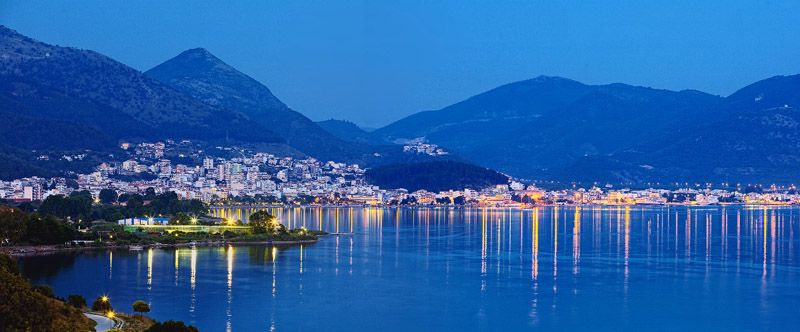
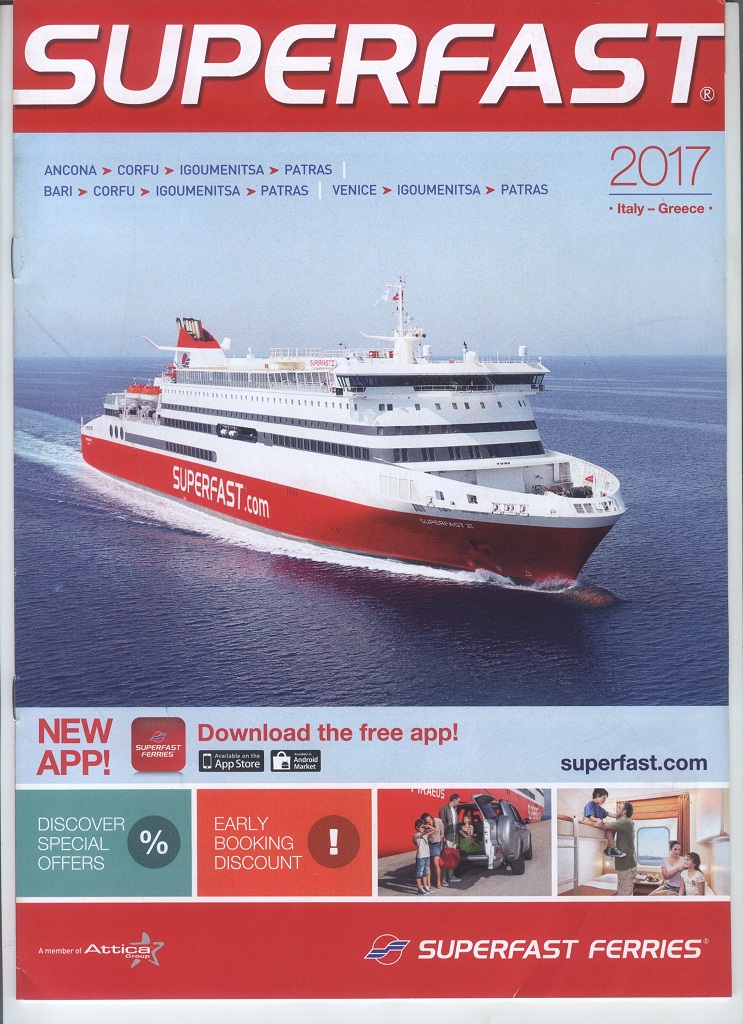
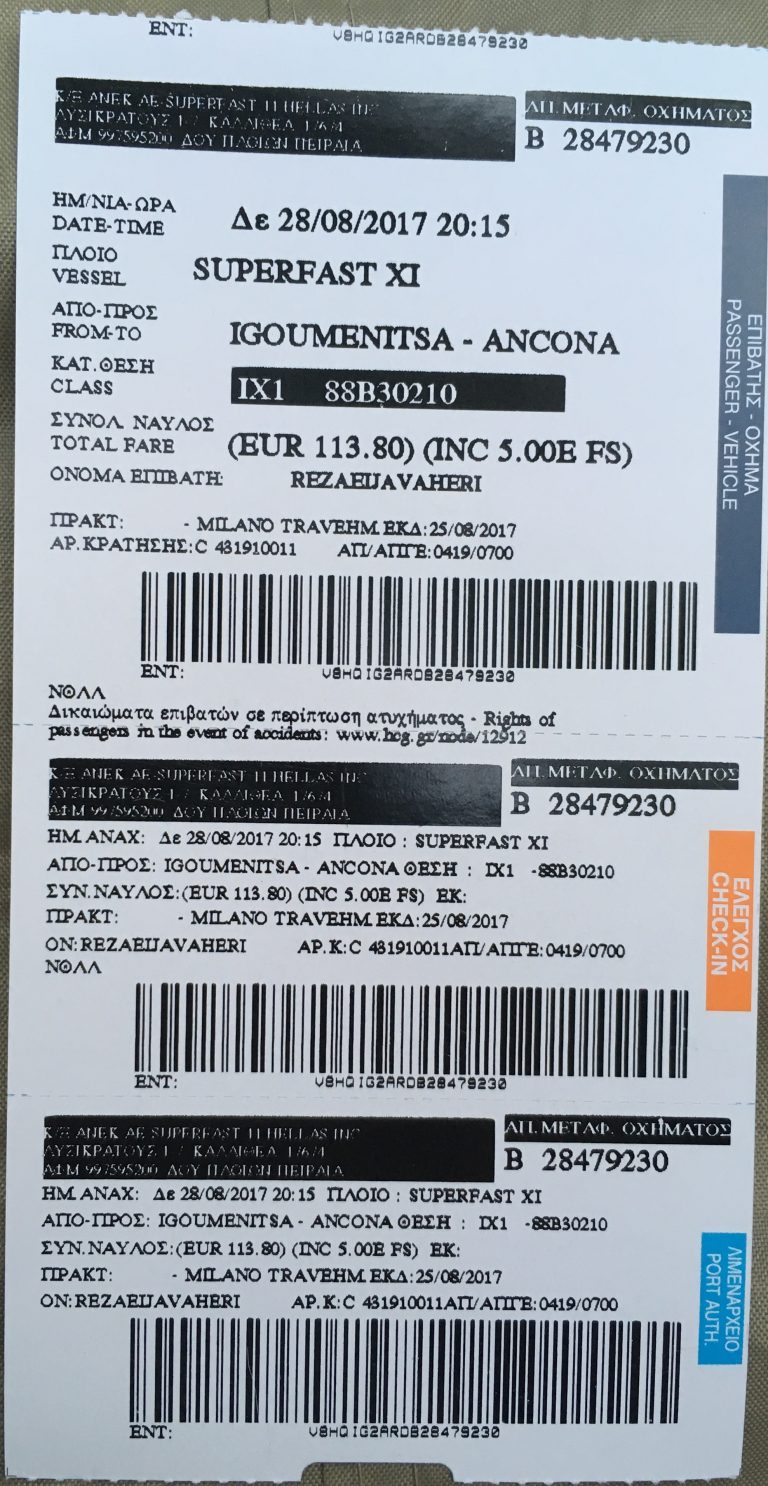
After obtaining the tickets, we started exploring the city.
We headed towards the beautiful beach campsite in Igoumenitsa and stayed there for three nights.
The campsite had excellent and abundant facilities, which were especially great for me as I have children.
The beautiful private beach (Greek beaches have some of the clearest waters in the world), swimming gear, surfing boards, various showers, toilets, laundry, kitchen, dishwasher, restaurant, store, and most importantly, free WIFI internet were available.
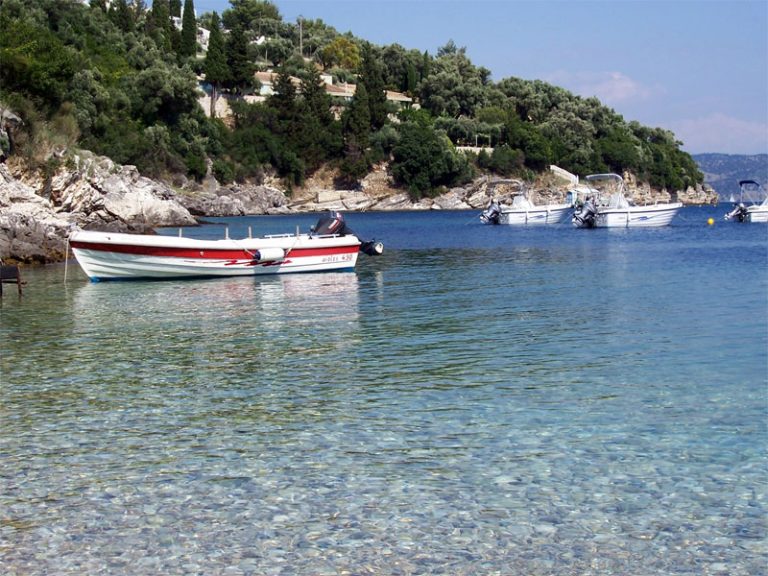
This campsite was full of families from all over Europe, and we became friends with a French couple and an Albanian.
Most Europeans were settled in this campsite with highly equipped campers, either in pairs or with their families, and some of them had facilities even more complete than a residential house.
The facilities included bathrooms, bedrooms, kitchens, satellite TV, gas coolers, motorcycles and bicycles, etc.
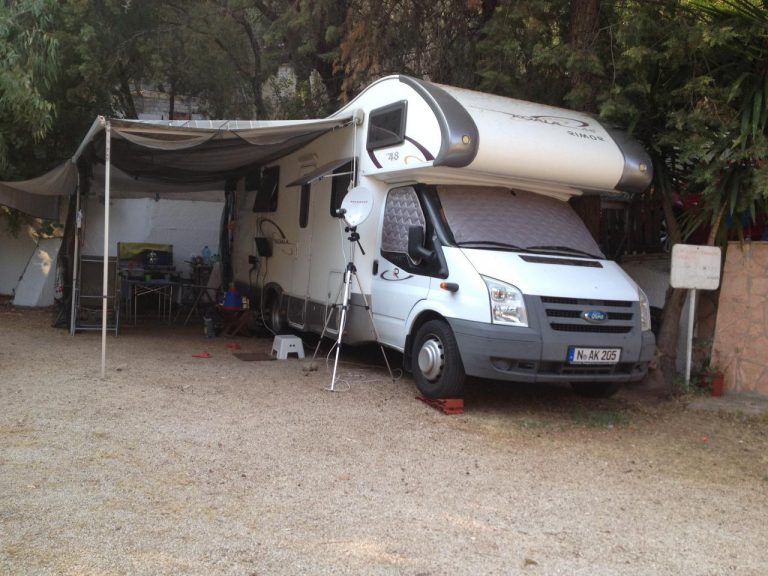

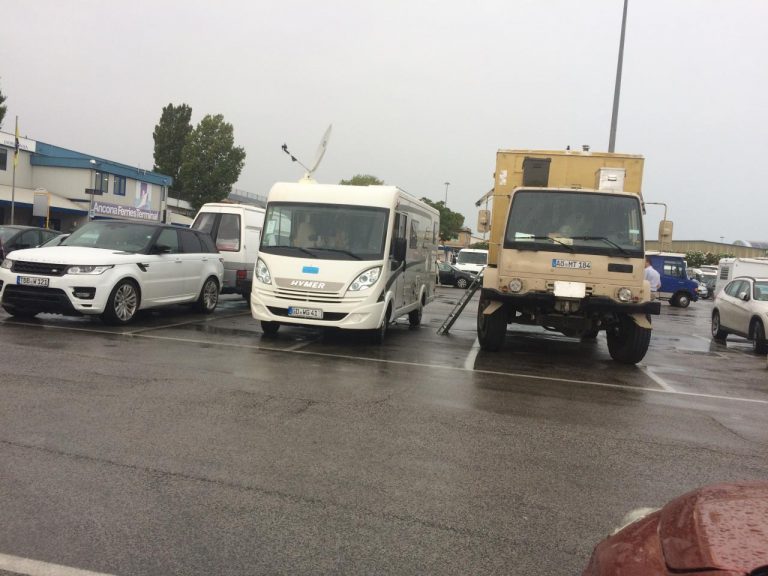
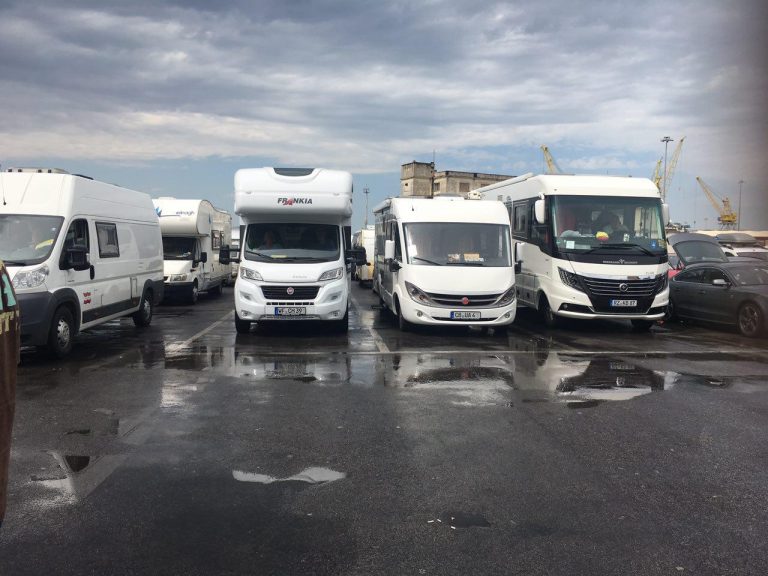
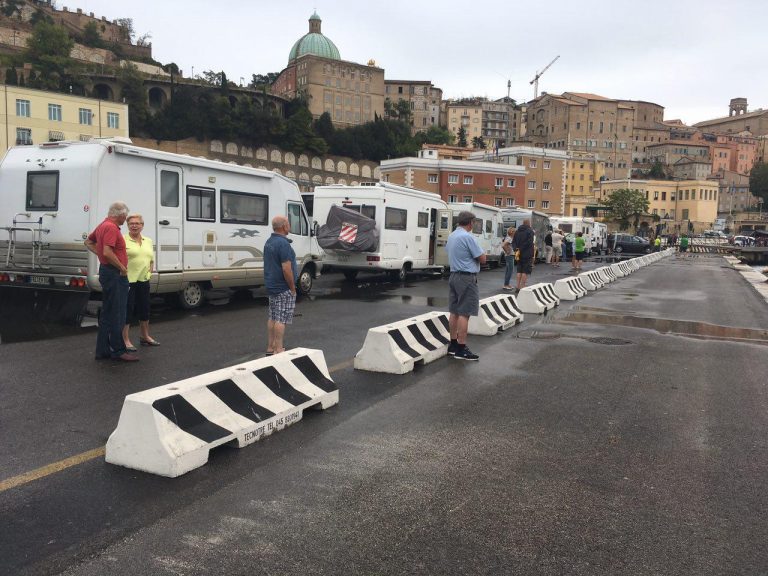


After the mandatory success that was created due to the cruise ticket, and a 3-night stay in this place with its dreamy beach and very clear water, we got ready to head towards the port of Igoumenitsa for the ticket check-in and preparation for the cruise ship journey.
At the port, the tickets were validated, and my family entered the port through the transit hall, while I entered separately from the vehicle entrance by presenting the ticket and vehicle documents.
The port, like an airport, has multiple gates because the routes of the ships differ. This beautiful port serves various destinations for ships.
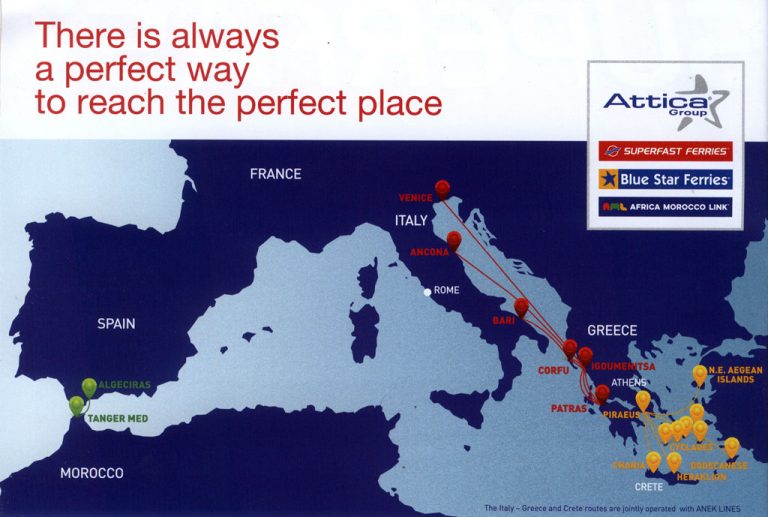
The exit gate for the port of Ancona was number 10.
Inside the port area, officials were busy organizing cars, trucks, and trailers using wireless communication. In the same area, Gate number 10 classified the vehicles based on their type, size, length, and height for different parking areas for the ships.
During the check-in process, they gave us a sign to hang on the car’s front windshield to differentiate the route for each vehicle. It said “Ancona Port.”
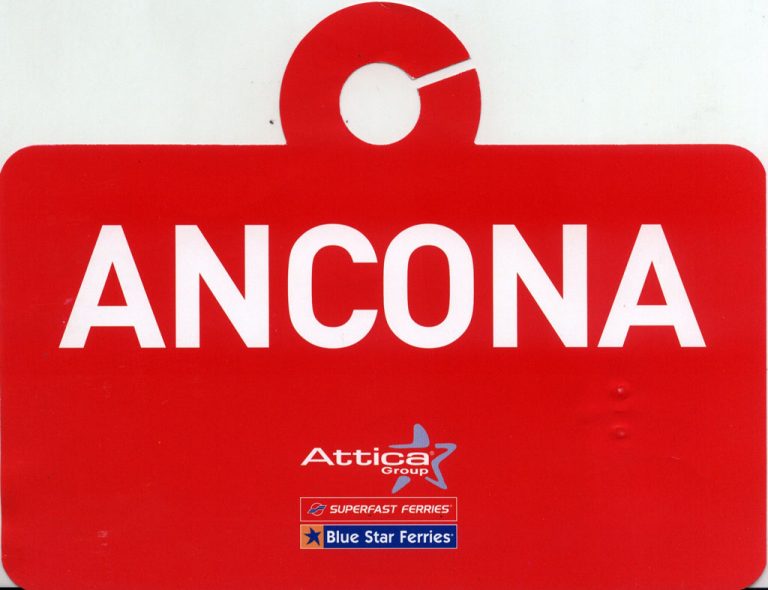
At the scheduled time, again, the family was taken from the passenger entrance, and the vehicles were directed from the dedicated ramp, which had 4 lanes.
Based on my friends’ experiences, I knew that after parking the car and passengers settling in, the parking doors would be closed, and we would no longer have access to the vehicles.
Therefore, my spouse and I had already discussed and determined the necessary items for the journey in advance.
My spouse took a part of the luggage with our children to the ship, while I took the rest upstairs using the elevator.
The travel time was approximately 17 hours, and the average speed of the ship, which I measured with GPS, was about 50 kilometers per hour.
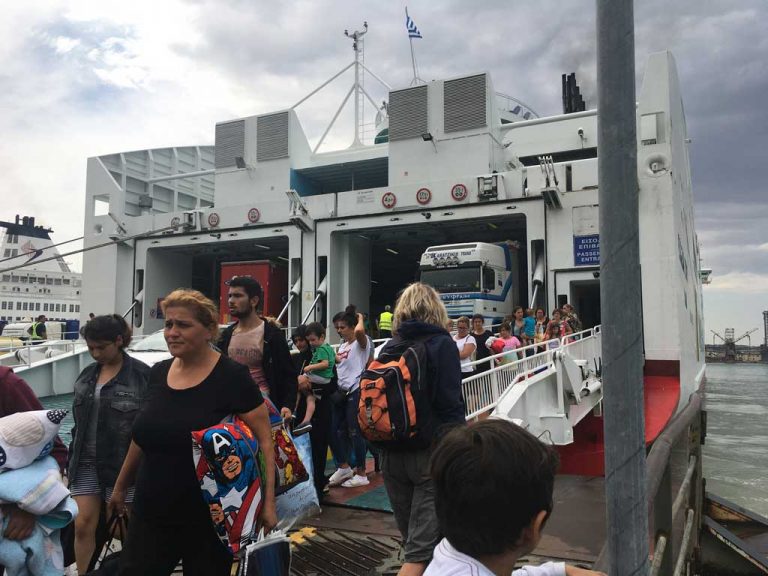
The ship was very large and had about 11 floors.
Floors 6 to 8 were for parking, and on the 9th floor, there were cabins and suites, while floors 10 and above were for restaurants, pools, bars, and more.
It had beautiful interior decorations, elevators, a children’s playroom, and a captivating design.
For me, it was a great experience of international sea travel, especially with my family and our car.

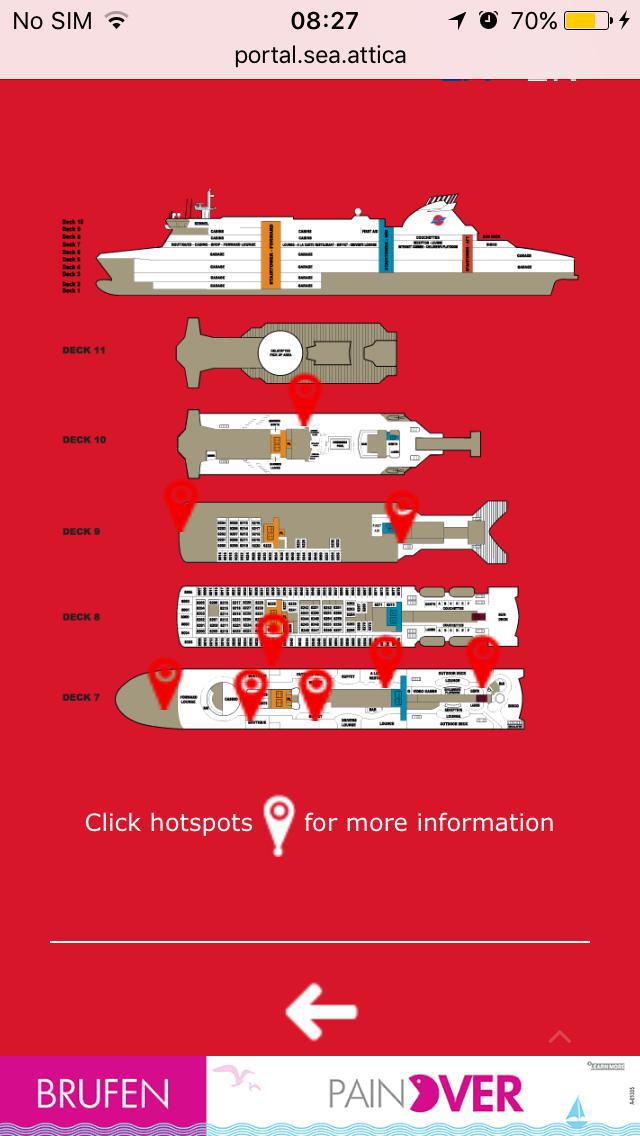
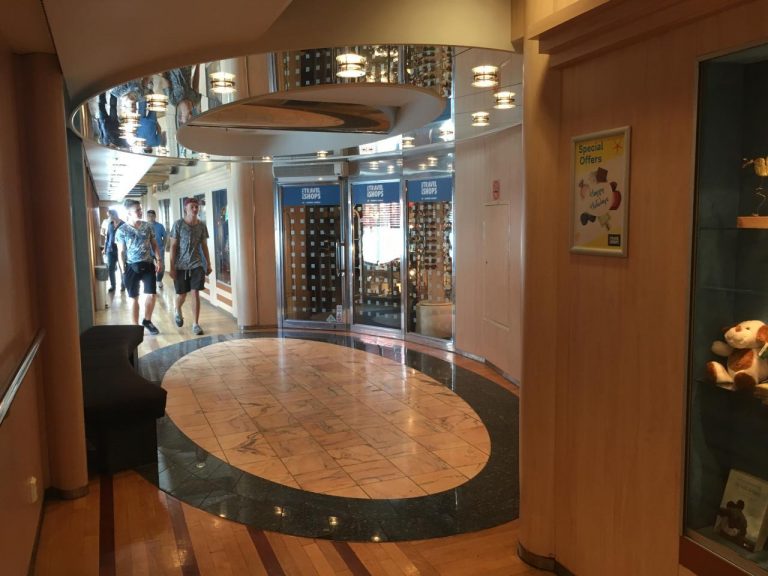



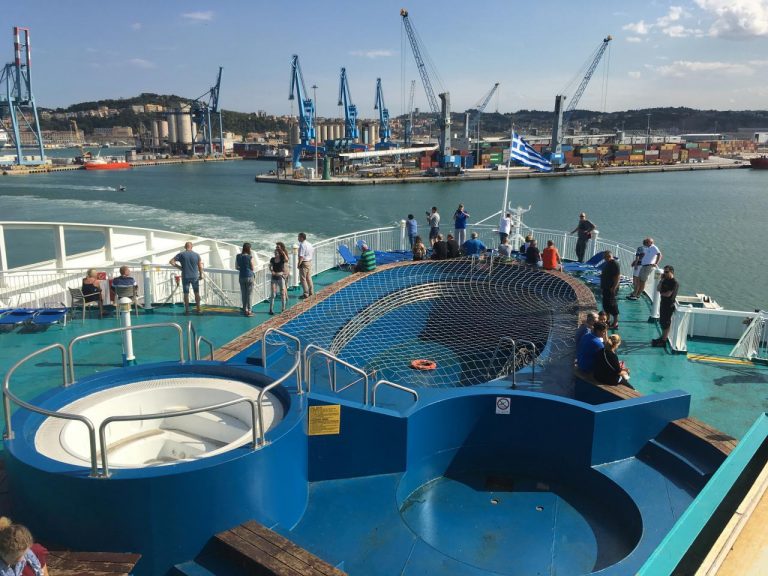

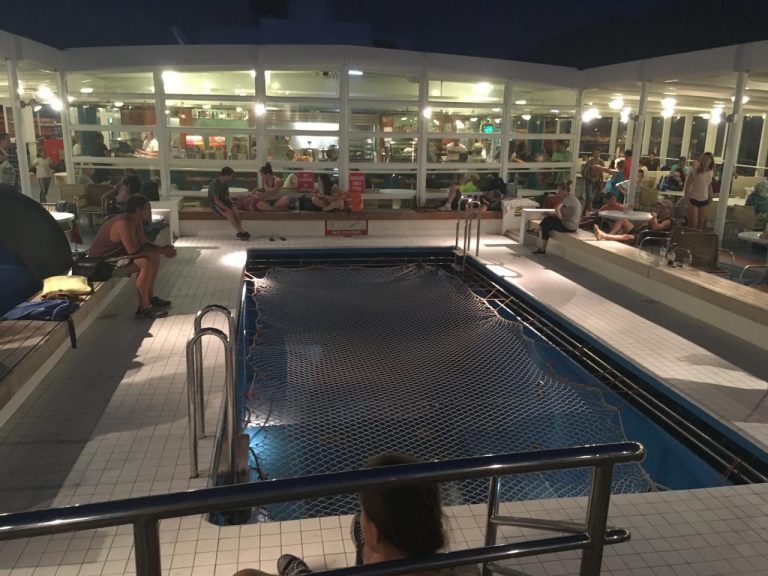
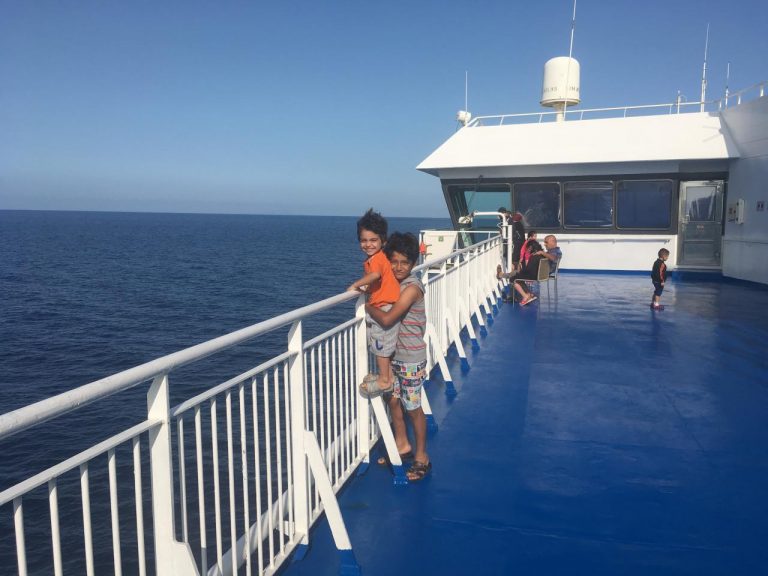

During this trip, I was amazed by the grandeur, size, and technologies used on this ship.
The ship’s parking area also had order and special systems. For example, various spiral-shaped sockets for electricity, walls for container refrigerators and compressor refrigerators, special floor hooks for securing trailers during potential storms, and various ramps and jacks for raising and lowering.
The entire ship’s electrical system was protected and moisture-resistant.
Part 5 - Arrival in Italy
At 11 o’clock the next day, we arrived in the port of Ancona, Italy.
The view of the city and the appearance of the port were very beautiful and attractive. It was announced through the speakers that drivers should go to the parking lot using the elevator, and passengers should exit the ship through the stairs.
However, drivers are sent to the parking lot a little earlier.
Immediately and much faster than the time of boarding, the ship was unloaded, and we started driving to the beautiful port city of Ancona, Italy, heading to Florence, Italy.
With the energy and excitement after a 17-hour rest on the ship, we took the road to Florence after some shopping at the Florence Way shop.
Florence, the birthplace of the Italian Renaissance, the city of Julius Caesar and Dante, the city of art, architecture, and sculpture.
This city is undoubtedly one of the most beautiful cities in the world.
Florence influences everyone and is one of the most popular destinations for tourists worldwide and the capital of art in Italy.
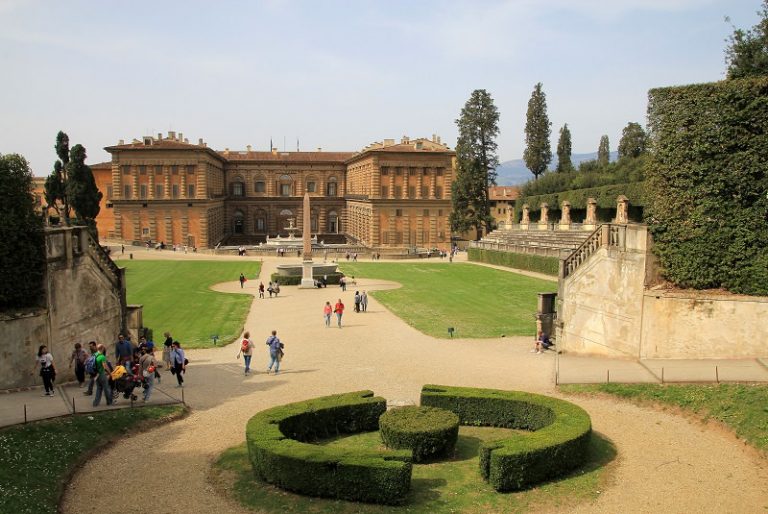
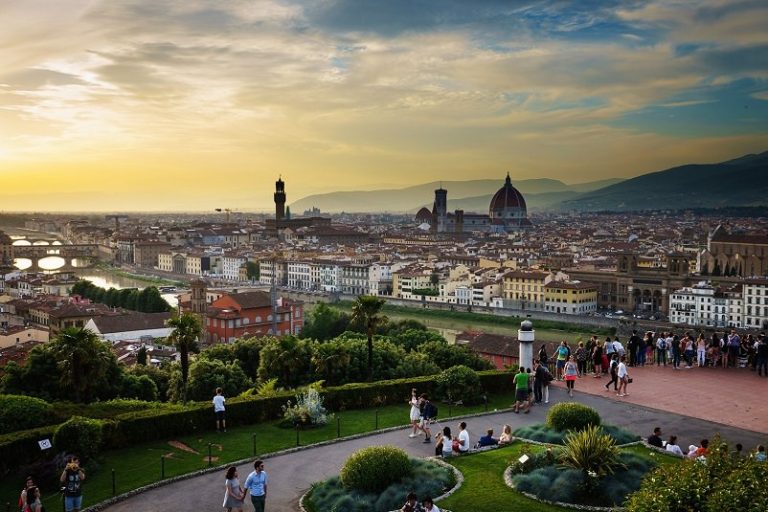
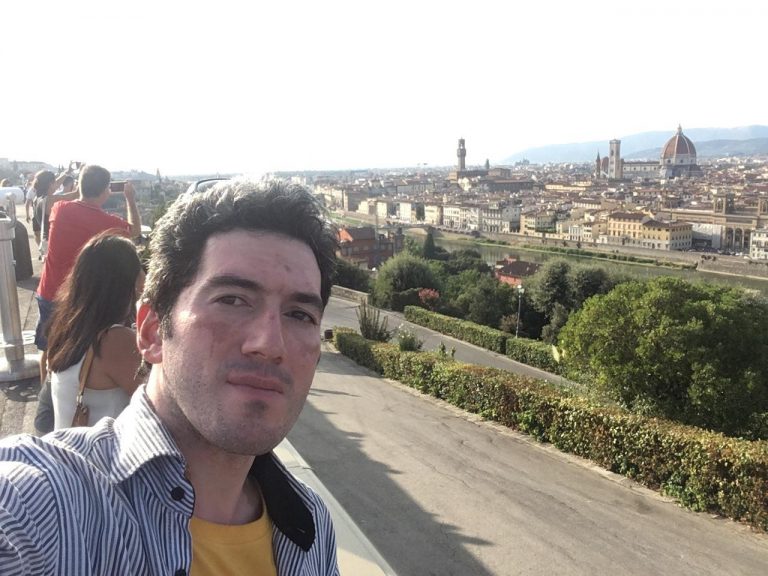
After wandering and staying in Florence, we headed towards Pisa.
Before starting our journey, I booked a hotel in the city of Pisa for an overnight stay through the Booking.com application.
The route from Florence to Pisa was also attractive, and we arrived at the hotel we had booked in Pisa at night.
When we arrived, the hotel receptionist had mistakenly taken an email for us and was shocked to see us.
I don’t know if they had given our room to someone else or if there were no vacant rooms.
They immediately apologized and to satisfy us, they provided us with a complete suite consisting of 2 bedrooms, a bathroom, a kitchen, and a living room, fully furnished, at the same price.
Fortunately, in this trip, forced luck was constantly with us, and we made the most of it.
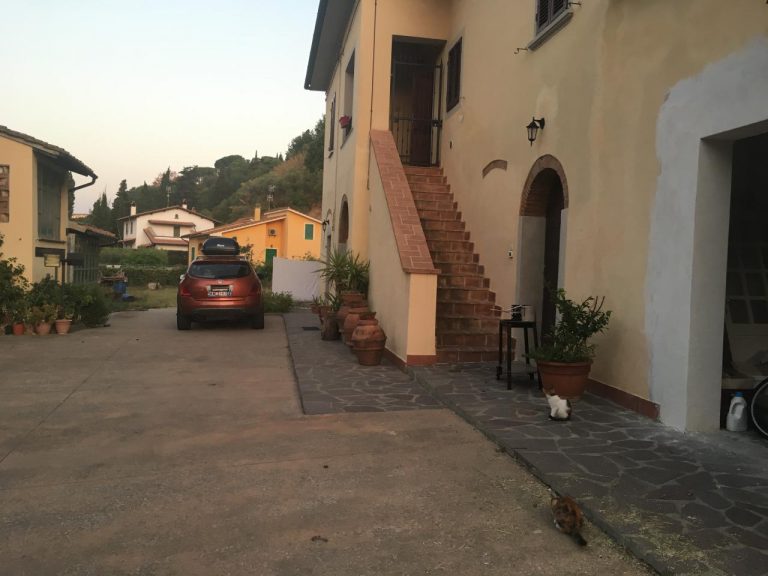
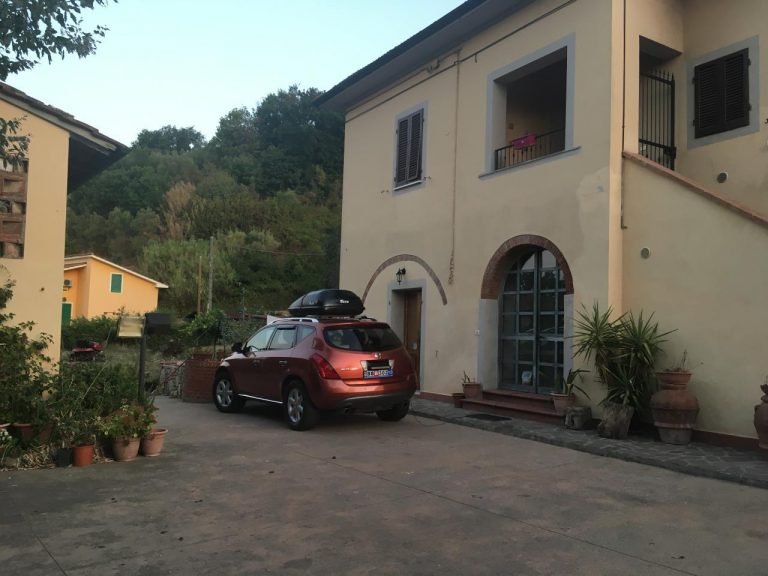
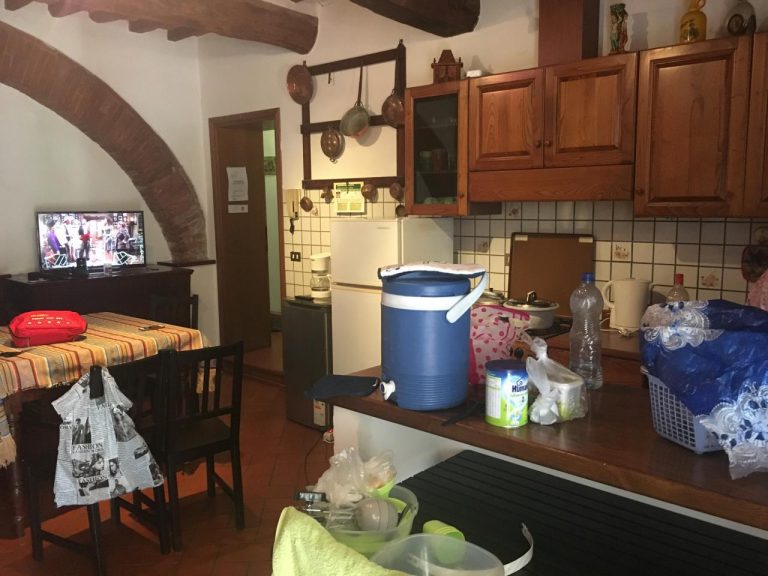
After a complete rest, we set off towards Milan, Italy in the morning.
We arrived in Milan around 3 a.m. because we had forgotten to book a hotel and, on the other hand, due to extreme fatigue and knowing the dangers we had heard about Italy, we parked by the main street of the city and, after locking the car doors and rolling up the windows, we started resting in the car.
Italian thieves
After a while, due to the heat inside the car, I had to roll down the windows a bit (about 10 centimeters) and resumed resting.
Suddenly, I woke up to the sound of my husband saying “thief, they took it” and I saw two people running with something in their mouths and one hand beside a bicycle, so I ran.
I was just a few centimeters away from them when they hopped on the bike and got away from me. Since I had moved away from the car, I was worried about it and thought to myself that this might have been a plan to empty the car. I quickly rushed back to the car, and thank God, everything was safe.
After checking, we realized that they had stolen a professional Canon camera, 4 pairs of sunglasses, and a sun hat. Despite the tiredness and sleepiness on one hand, waking up in that manner and the unpleasant feeling after being robbed made us detest dirty and thieving people in Italy.
After contacting the police and going to the scene, they announced that those thieves were Moroccans and they have a habit of stealing. The police opened a case for us, but I don’t think it will be of much value, and they told us that we can inquire at any police station after three months.
On the way back to Iran, in Greece, I saw an Iranian transit driver whom we had greeted and honked at on the road before. He was surprised that we had traveled to Europe by car, and he asked us how far we had gone. After giving him a detailed explanation, I told him about the theft incident. Then I realized that Italians are even more dangerous than what I described, and he shared his experiences, saying that thieves use any tools, including sprays and more! I just didn’t ask whether it was a stun spray or pepper spray.
In summary, the danger passed, while security is good in Turkey, Greece, France, and Switzerland. Apparently, friends need to be extra cautious in Italy and make sure everything is secured.
Part 6 - Mont Blanc, the Alps Mountain Range, and entering France
Mont Blanc Peak in the Alps

Undoubtedly, one of the most beautiful and memorable parts of the journey is Mont Blanc and Chamonix.
Chamonix-Mont-Blanc is a beautiful village, but very cold and foggy. To enter France, you must pass through the Alps mountains and the largest peak among them, called Mont Blanc.
Let me provide some information about the Alps mountain range before continuing the travelogue:
The Alps mountain range is one of the largest mountain ranges in Europe, passing through eight European countries.
The Alps extend from Austria and Slovenia in the east to Italy, Switzerland, Liechtenstein, Germany, France, and Monaco in the west. Mont Blanc is the highest peak in the Alps, standing at approximately 4,811 meters and located on the border between Italy and France.
This mountain range is shaped like a rainbow by William Coolidge (W.A.B. Coolidge) (۱۹۲۶-۱۸۵۰ ), a famous mountaineer and historian, divided these mountains into three main groups:
- Group One – Western Alps from Tande Pass to Simplon
- Group Two – Central Alps from Simplon to Reshen Scheideck and Stelvio
- Group Three – Eastern Alps from Reshen Scheideck to Rastatter Tauern
Each of these three groups is further divided into several subgroups.
The highest peak in the Alps is Mont Blanc, reaching 4,807 meters.
Total number of independent peaks above 4000 meters in this mountain range is 52, and if we consider multiple peaks, this number reaches 62.
This mountain range has permanent snow and ice covering the major part of the Alps, and there are numerous glaciers, the longest of which is approximately 22 kilometers called Greal Alctsch.
It is said that the English name “Alps” is derived from the Latin word “Alpes,” which is synonymous with the Latin word “Albus,” meaning “white.”
The Alps mountain range is a natural phenomenon that has formed as a result of the collision of the African and European continental plates, leading to the disappearance of the western part of the Tethys Ocean that used to be located between these two continents.
The pressure resulting from this collision caused bending and uplifts that emerged from the Tethys Sea and were pushed northwards.
The Alps mountains have a countless number of hotels, guesthouses, shelters, and refuges, and at the same time, there are various amenities available such as professional guides, rescue teams, and various mountain transportation facilities.
The Alps have been the birthplace of mountaineering and have played an unparalleled role in the history of this sport. In European languages, the term “Alpinism” or “Alpinisme” is used to refer to mountaineering (climbing high mountains, technical climbing).
Many tourists come to this region during the summer and winter seasons. During the months of December to April, winter sports such as skiing and snowboarding have a large number of enthusiasts in the Alps. During the summer, most people interested in mountaineering and hiking visit there. Every year in July, the “Tour de France” cycling race is held in the Alpine region for three weeks. Most Alpine cities have suitable roads and can be accessed by car.
Now that you have gained more familiarity with the Alps, I would like to inform you that there is a tunnel for crossing under its highest peak. By paying approximately 40 to 45 euros (for vehicles), you can enter France from Italy without any worries and in the shortest possible time. However, this tunnel is highly advanced and has its own special instructions that you will receive upon entering it and paying the toll at the respective booth.
You may wonder what these instructions and special precautions are for. First, I need to write about the characteristics of this tunnel:
Mont Blanc Tunnel
The Mont Blanc Tunnel connects the cities of Chamonix-Mont-Blanc in France and Courmayeur in Italy. The distance between the two cities can be covered in about 15 minutes by car.
In 1962, French and Italian workers started advancing beneath the majestic Mont Blanc peak at an altitude of approximately 3,000 meters in the Alps mountain range, reaching the border of the two countries. It took several more years to complete the Mont Blanc Tunnel for use.
In July 1965, Charles de Gaulle, the President of France (left), and his Italian counterpart Giuseppe Saragat inaugurated the Mont Blanc Tunnel. The responsibility for this tunnel lies with both countries. Two French and Italian companies each took responsibility for half of this project.
The Mont Blanc Tunnel is located at a depth of 3,800 meters in the Alps mountain range. Before the construction of this tunnel, individuals who wanted to travel from one side to the other faced numerous difficulties. Mont Blanc is a French word meaning “white mountain.” In Italian, it is called “Monte Bianco,” which has the same meaning.
The Mont Blanc Tunnel connects the cities of Chamonix-Mont-Blanc in France and Courmayeur in Italy. The distance between the two cities can be covered in about 15 minutes
The length of the Mont Blanc Tunnel is 6.11 kilometers. The danger of this tunnel is that it is a two-way route. According to regulations, every vehicle must maintain a distance of 150 meters from the vehicle in front of it. The maximum speed for vehicles in this tunnel is also set at 70 kilometers per hour. The border between the two countries is located near the entrance to the tunnel from Italy.
In 1999 (16 years ago), a Belgian truck caught fire in the Mont Blanc Tunnel. In this incident, 39 people lost their lives. Even after years of investigation, the exact cause of the accident has not been clarified. It is likely that the ignition of a cigarette caused the fire in the truck’s cargo.
What is known is that the tunnel’s air system did not have the capability to quickly remove flammable gases inside the tunnel. In such conditions, the tunnel’s warning systems also did not function properly. The incident occurred in the French section of the tunnel but was controlled by an Italian company.
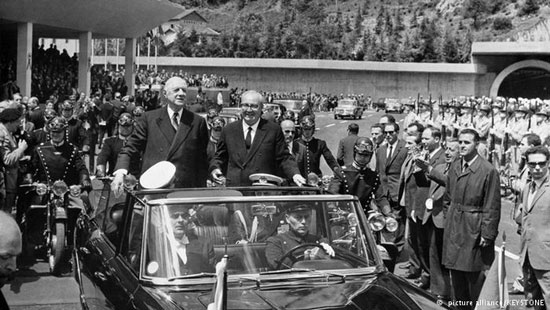
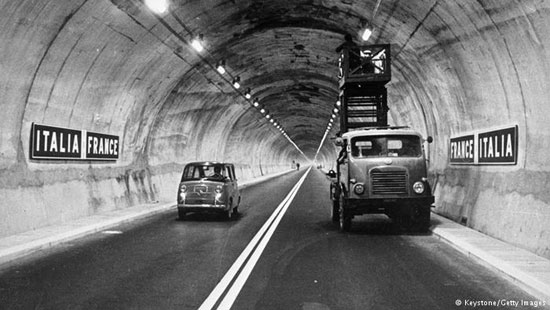
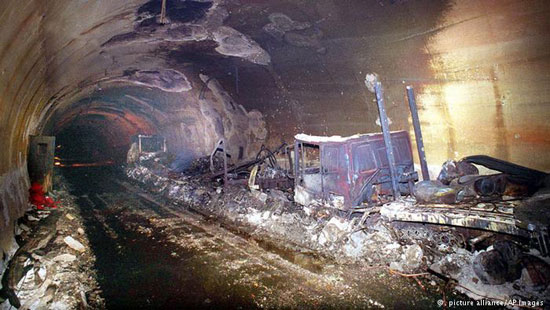
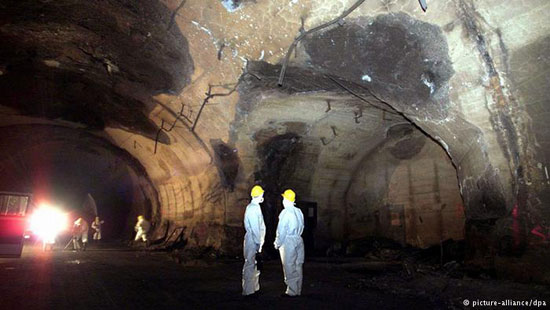
After the mentioned incident, the Mont Blanc Tunnel was closed for three full years. All sections of the tunnel were renovated, especially the modern fire prevention systems. In 2002, the Mont Blanc Tunnel was reopened, and traffic resumed. The Mont Blanc fire prompted discussions worldwide to enhance the safety of tall tunnels.
Taking care of a tunnel that is more than 11 kilometers long also includes expenses. For this reason, tolls are collected from passengers to pass through this tunnel. The toll fee at the French entrance is 5.43 euros, and it is more expensive at the Italian entrance (20.44 euros).
The Mont Blanc Tunnel is still a vital and short route between France and Italy. Last year, about 5,000 vehicles passed through this tunnel daily. Trucks pass through the tunnel in groups of five, accompanied by a support vehicle. This is another safety measure implemented in the tunnel after the 1999 fire.

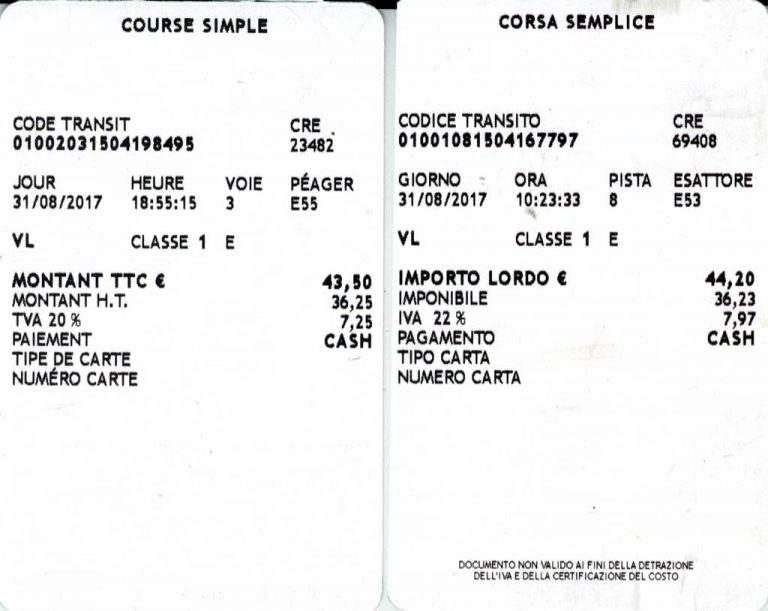
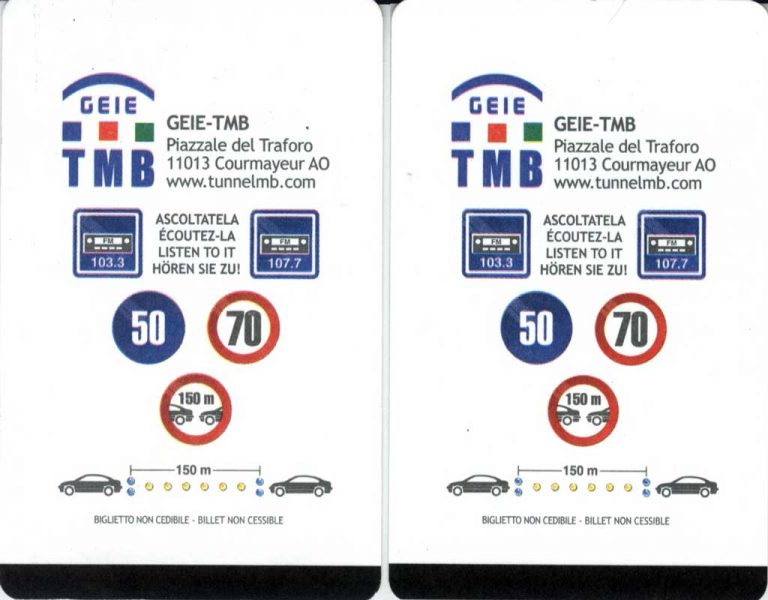
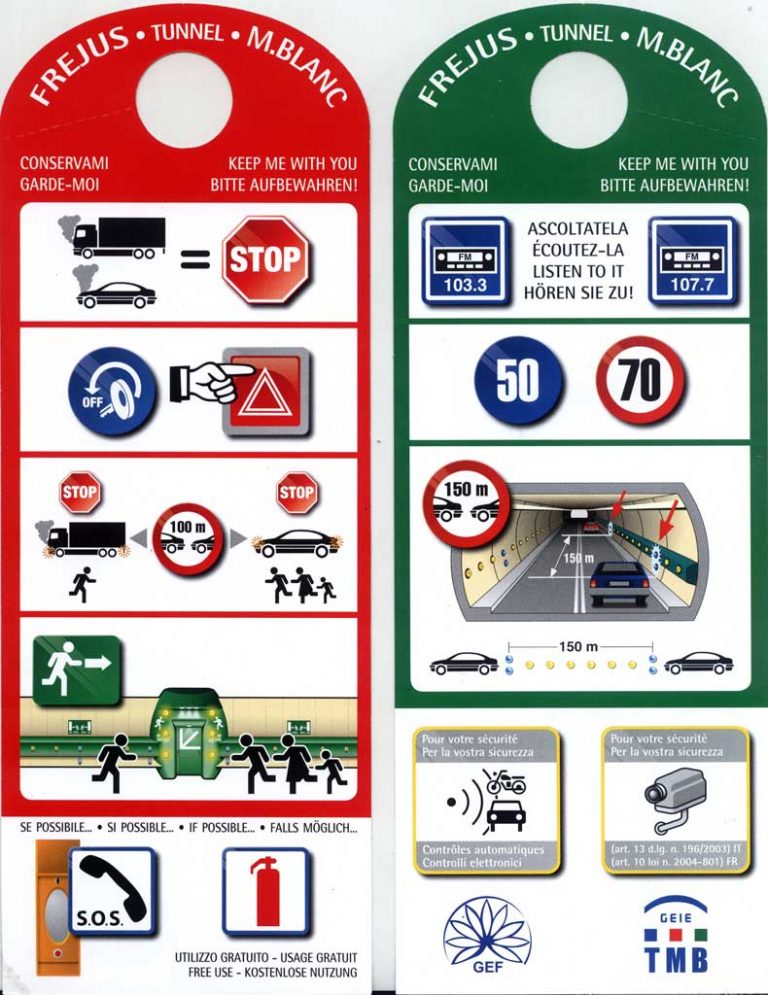
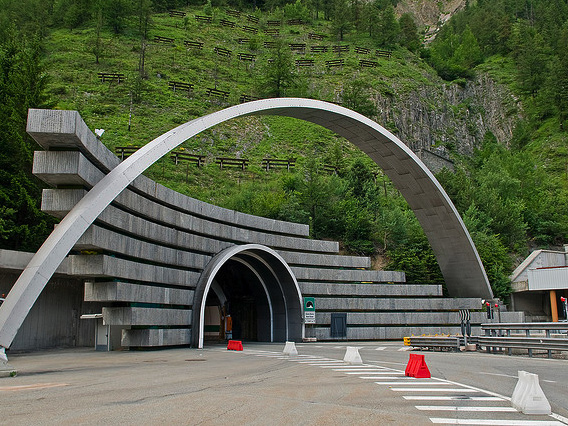

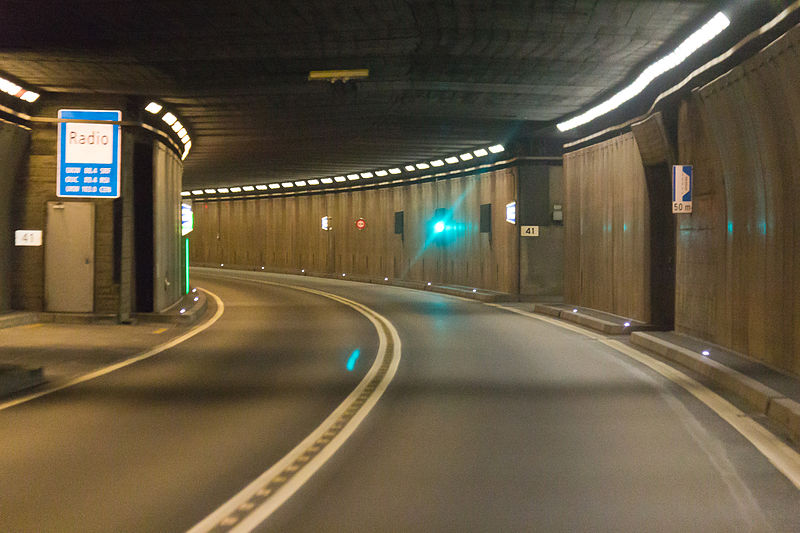
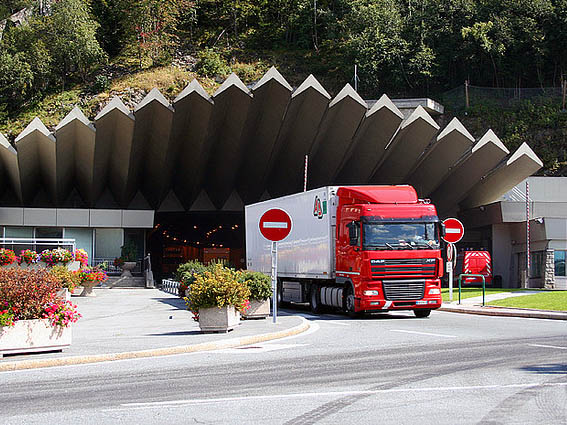
After passing through the toll tunnel, the French police were conducting vehicle checks, as usual. They saw the Iranian license plate and signaled us to stop. They checked our passports through the driver’s side window and asked the usual questions: Where did you come from? Where are you going? What is your occupation in Iran? They were polite and respectful. They returned our passports and we continued our journey.
This action by the French police seemed more out of curiosity because one of their questions was how we managed to drive all the way.
Afterward, we entered France and after refueling the car, we headed towards Switzerland.
The distance between the Mont Blanc Tunnel, the entrance to France, and Switzerland was about 88 kilometers. After covering this distance, we arrived in the city of Geneva and parked around the famous Lake Geneva. We spent time exploring the area.
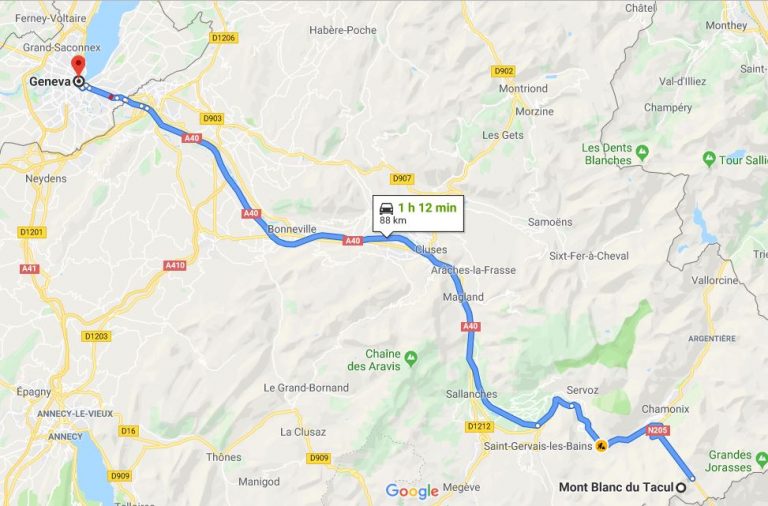
This was my second time coming to Switzerland, but it was the first time for my children and my spouse. The weather in Switzerland was very cold and rainy, which was a bit shocking for us, as we were wearing summer clothes from Italy. We had to take out warm clothes from the car and put them on.
Although Switzerland is part of the European Union, its currency is still the Swiss Franc. I had to convert Euros into Francs at a chain store for shopping. Lake Geneva is very beautiful and worth visiting, with a large fountain in the middle.
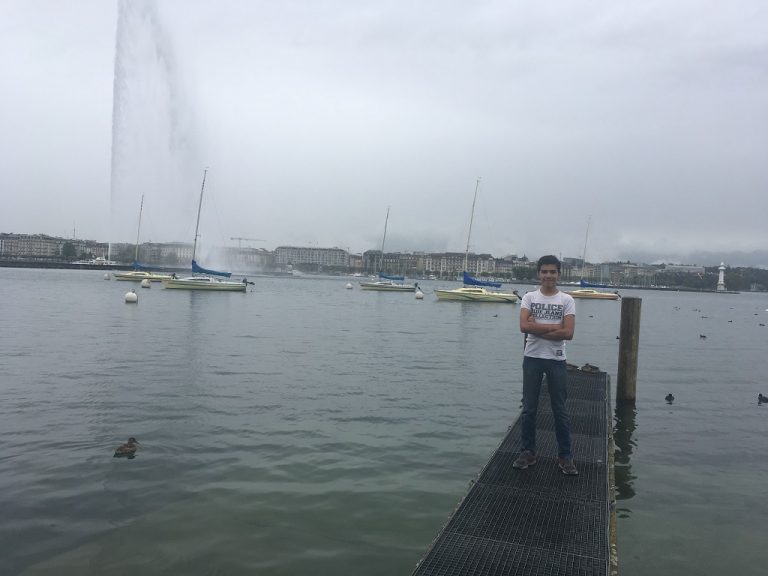

The fountain has a height of about 140 meters, a speed of 200 kilometers per hour, a flow rate of 500 liters per second, and a 1,000-kilowatt motor, as indicated in the image.
There are also seagulls and various aquatic animals in the lake, and people feed them.
Around the lake and on the large buildings, there are billboards and signs of international brands. Cleanliness and orderliness prevail in the city. Overall, the road markings in Europe are quite complicated for us Iranians.
At a four-way intersection, there are markings for the passage of cars, bicycles, trains, and pedestrians. Due to the severe cold and rain, we decided to return to France after staying in Switzerland for a day.
Since we had traveled to France several times before and visited several cities by car, we decided to avoid staying in France this time and return to Italy.
Continued in the second part
